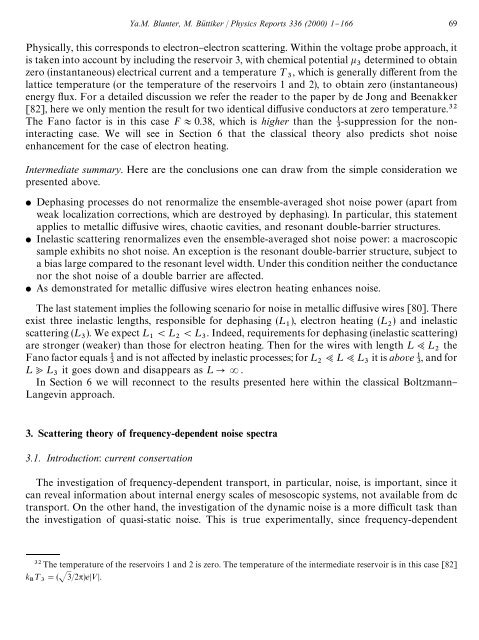shot noise in mesoscopic conductors - Low Temperature Laboratory
shot noise in mesoscopic conductors - Low Temperature Laboratory
shot noise in mesoscopic conductors - Low Temperature Laboratory
Create successful ePaper yourself
Turn your PDF publications into a flip-book with our unique Google optimized e-Paper software.
Physically, this corresponds to electron}electron scatter<strong>in</strong>g. With<strong>in</strong> the voltage probe approach, it<br />
is taken <strong>in</strong>to account by <strong>in</strong>clud<strong>in</strong>g the reservoir 3, with chemical potential determ<strong>in</strong>ed to obta<strong>in</strong><br />
zero (<strong>in</strong>stantaneous) electrical current and a temperature ¹ , which is generally di!erent from the<br />
lattice temperature (or the temperature of the reservoirs 1 and 2), to obta<strong>in</strong> zero (<strong>in</strong>stantaneous)<br />
energy #ux. For a detailed discussion we refer the reader to the paper by de Jong and Beenakker<br />
[82], here we only mention the result for two identical di!usive <strong>conductors</strong> at zero temperature.<br />
The Fano factor is <strong>in</strong> this case F+0.38, which is higher than the -suppression for the non<strong>in</strong>teract<strong>in</strong>g<br />
case. We will see <strong>in</strong> Section 6 that the classical theory also predicts <strong>shot</strong> <strong>noise</strong><br />
enhancement for the case of electron heat<strong>in</strong>g.<br />
Intermediate summary. Here are the conclusions one can draw from the simple consideration we<br />
presented above.<br />
Dephas<strong>in</strong>g processes do not renormalize the ensemble-averaged <strong>shot</strong> <strong>noise</strong> power (apart from<br />
weak localization corrections, which are destroyed by dephas<strong>in</strong>g). In particular, this statement<br />
applies to metallic di!usive wires, chaotic cavities, and resonant double-barrier structures.<br />
Inelastic scatter<strong>in</strong>g renormalizes even the ensemble-averaged <strong>shot</strong> <strong>noise</strong> power: a macroscopic<br />
sample exhibits no <strong>shot</strong> <strong>noise</strong>. An exception is the resonant double-barrier structure, subject to<br />
a bias large compared to the resonant level width. Under this condition neither the conductance<br />
nor the <strong>shot</strong> <strong>noise</strong> of a double barrier are a!ected.<br />
As demonstrated for metallic di!usive wires electron heat<strong>in</strong>g enhances <strong>noise</strong>.<br />
The last statement implies the follow<strong>in</strong>g scenario for <strong>noise</strong> <strong>in</strong> metallic di!usive wires [80]. There<br />
exist three <strong>in</strong>elastic lengths, responsible for dephas<strong>in</strong>g (¸ ), electron heat<strong>in</strong>g (¸ ) and <strong>in</strong>elastic<br />
scatter<strong>in</strong>g (¸ ). We expect ¸ (¸ (¸ . Indeed, requirements for dephas<strong>in</strong>g (<strong>in</strong>elastic scatter<strong>in</strong>g)<br />
are stronger (weaker) than those for electron heat<strong>in</strong>g. Then for the wires with length ¸;¸ the<br />
Fano factor equals and is not a!ected by <strong>in</strong>elastic processes; for ¸ ;¸;¸ it is above , and for<br />
¸
















